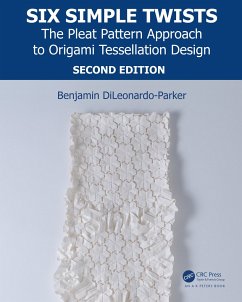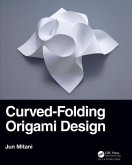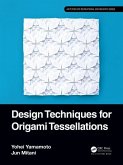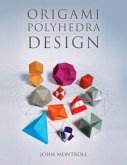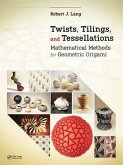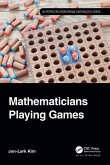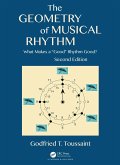Benjamin DiLeonardo-Parker
Six Simple Twists
The Pleat Pattern Approach to Origami Tessellation Design
Benjamin DiLeonardo-Parker
Six Simple Twists
The Pleat Pattern Approach to Origami Tessellation Design
- Broschiertes Buch
- Merkliste
- Auf die Merkliste
- Bewerten Bewerten
- Teilen
- Produkt teilen
- Produkterinnerung
- Produkterinnerung
In this thoroughly updated second edition, the book explores new techniques and example tessellations, with full-page images, and mathematical analysis of the patterns. A reader will, through practice, gain the ability to create still more complex and fascinating designs.
Andere Kunden interessierten sich auch für
![Curved-Folding Origami Design Curved-Folding Origami Design]() Jun Mitani (Japan University of Tsukuba)Curved-Folding Origami Design60,99 €
Jun Mitani (Japan University of Tsukuba)Curved-Folding Origami Design60,99 €![Origami Design Secrets Origami Design Secrets]() Robert J. LangOrigami Design Secrets223,99 €
Robert J. LangOrigami Design Secrets223,99 €![Design Techniques for Origami Tessellations Design Techniques for Origami Tessellations]() Yohei YamamotoDesign Techniques for Origami Tessellations39,99 €
Yohei YamamotoDesign Techniques for Origami Tessellations39,99 €![Origami Polyhedra Design Origami Polyhedra Design]() John MontrollOrigami Polyhedra Design51,99 €
John MontrollOrigami Polyhedra Design51,99 €![Twists, Tilings, and Tessellations Twists, Tilings, and Tessellations]() Robert J. Lang (http: / / www.langorigami.com, Alamo, California, USA)Twists, Tilings, and Tessellations97,99 €
Robert J. Lang (http: / / www.langorigami.com, Alamo, California, USA)Twists, Tilings, and Tessellations97,99 €![Mathematicians Playing Games Mathematicians Playing Games]() Jon-Lark KimMathematicians Playing Games47,99 €
Jon-Lark KimMathematicians Playing Games47,99 €![The Geometry of Musical Rhythm The Geometry of Musical Rhythm]() Godfried T. ToussaintThe Geometry of Musical Rhythm76,99 €
Godfried T. ToussaintThe Geometry of Musical Rhythm76,99 €-
-
-
In this thoroughly updated second edition, the book explores new techniques and example tessellations, with full-page images, and mathematical analysis of the patterns. A reader will, through practice, gain the ability to create still more complex and fascinating designs.
Hinweis: Dieser Artikel kann nur an eine deutsche Lieferadresse ausgeliefert werden.
Hinweis: Dieser Artikel kann nur an eine deutsche Lieferadresse ausgeliefert werden.
Produktdetails
- Produktdetails
- AK Peters/CRC Recreational Mathematics Series
- Verlag: Taylor & Francis Ltd
- 2 ed
- Seitenzahl: 308
- Erscheinungstermin: 8. September 2020
- Englisch
- Abmessung: 250mm x 202mm x 16mm
- Gewicht: 852g
- ISBN-13: 9781138311886
- ISBN-10: 113831188X
- Artikelnr.: 59994095
- Herstellerkennzeichnung
- Libri GmbH
- Europaallee 1
- 36244 Bad Hersfeld
- gpsr@libri.de
- AK Peters/CRC Recreational Mathematics Series
- Verlag: Taylor & Francis Ltd
- 2 ed
- Seitenzahl: 308
- Erscheinungstermin: 8. September 2020
- Englisch
- Abmessung: 250mm x 202mm x 16mm
- Gewicht: 852g
- ISBN-13: 9781138311886
- ISBN-10: 113831188X
- Artikelnr.: 59994095
- Herstellerkennzeichnung
- Libri GmbH
- Europaallee 1
- 36244 Bad Hersfeld
- gpsr@libri.de
Born in Pittsburgh and living in Connecticut, Benjamin DiLeonardo-Parker has an active student of origami tessellations since 2007. He has taught and exhibited at origami conventions and art shows internationally, including Chi Mei Museum (Tainan City, Taiwan), La Escuela-Museo Origami de Zaragosa (Zaragosa, Spain), The Science Museum Oklahoma (Oklahoma City, OK), the Museum of Mathematics (New York, NY), the Japan Information and Culture Center (Washington D.C.), The New Britain Museum of American Art (New Britain, CT), and the Cooper Union Gallery (New York, NY). Outside of art, Ben teaches high school mathematics to students with uncommon learning styles, and incorporates origami into his classes as often as he can. Ben approaches his artwork from a holistic standpoint, preferring to view origami as an entry into the vast network of disciplines to which it is connected. This has led him to extend his knowledge of education, engineering, mathematics, CNC fabrication, paper arts, fashion, alternative photography, and other studies. When not teaching high school math, Ben operates a workshop in Essex, CT out of which he creates artwork and runs classes on origami design, He views his practice of origami as cyclical and recursive. Origami is connected to such as vast network of disciplines, each with its own siren's call. Each flavor, each culture, cycles back onto its own basics over and over, swirling and interacting with previous knowledge, each enhancing the others in some way.
Part I 1.00
Why Study Pleat Patterns? 1.01
Basics and Preparation 1.02
How Pleat Patterns Differ from Traditional Origami 1.03
How to Read the Diagrams and Fold Parity 1.04
Folding Uniform Parallel Creases 1.05
Grid Axes and How to Fold a Hexagon 1.06
How to Fold a Triangle Grid 1.07
Simple Pleat 1.08
The Six Simple Twists 1.09
Triangle Twist 1.10
Triangle Spread 1.11
Hex Twist 1.12
Hex Spread 1.13
Rhombic Twist 1.14
Arrow Twist 1.15
Anatomy of a Molecule 1.16
Pleat Intersection Notation Part II 2.00
How to Use the Six Simple Twists 2.01
32nd's Grid 2.02
Locking and Unlocking Pleats 2.03
Triangle Twist Tessellation 2.04
3.6.3.6 Tessellation 2.05
Tessellation Basics 2.06
Applying Tessellation Knowledge Folding 2.07
Triangle Weave Tessellation 2.08
3.6.3.6 Weave Tessellation 2.09
6.6.6 Hexagonal Failing Cluster 2.10
Modifications 2.11
Backtwisting 2.12
Twist Handedness and Pleat Symmetry 2.13
Pleat Flattening 2.14
Triangle Twist Tessellation with Flattened Pleats 2.15
Hidden Circles Pattern 2.16
Rhombic Twist Tessellation 2.17
Rhombic Twist Variants 2.18
Twist Sinking 2.19
Twist Expansion 2.20
Nub Offset Tessellation 2.21
Shift Rosette Tessellation 2.22
Ridge Creation 2.23
Button Molecule 2.24
Button Molecule Tessellation 2.25
Triangle Flagstone Tessellation and Offsetting Pleats 2.26
3.6.3.6 Flagstone Tessellation 2.27
Crooked Split 2.28
Snowflake Tessellation 2.29
Tulip Split 2.30
Tulip Split Tessellation 2.31
Molecule Size and Different Grid Densities 2.32
"Front" and "Back" Sides 2.33
Tendril Tessellation 2.34
Inverting a Pleat 2.35
Iso
Area Triangle Twist Tessellation 2.36.
Pleat Pushing 2.37
Platform Tess 2.38
Triple Twist Tess Part III 3.00
Pleat Patterns as Artwork 3.01
Gallery 3.02
Pleat
to
Molecule Analysis 3.03
Twist Archetype Sets 3.04
Molecule Database 3.05
Archetype Composition 3.06
Actions and Notation 3.07
Splitting Equation 3.08
Normal Polygon Models 3.09
Circle Cutout Model 3.10
Molecule
to
Pleat Analysis 3.11
Sectioning Model of Perfect Twist Design 3.12
Brocard Points Final thoughts Pleat Notation Thoughts By Matthew Benet Glossary
Why Study Pleat Patterns? 1.01
Basics and Preparation 1.02
How Pleat Patterns Differ from Traditional Origami 1.03
How to Read the Diagrams and Fold Parity 1.04
Folding Uniform Parallel Creases 1.05
Grid Axes and How to Fold a Hexagon 1.06
How to Fold a Triangle Grid 1.07
Simple Pleat 1.08
The Six Simple Twists 1.09
Triangle Twist 1.10
Triangle Spread 1.11
Hex Twist 1.12
Hex Spread 1.13
Rhombic Twist 1.14
Arrow Twist 1.15
Anatomy of a Molecule 1.16
Pleat Intersection Notation Part II 2.00
How to Use the Six Simple Twists 2.01
32nd's Grid 2.02
Locking and Unlocking Pleats 2.03
Triangle Twist Tessellation 2.04
3.6.3.6 Tessellation 2.05
Tessellation Basics 2.06
Applying Tessellation Knowledge Folding 2.07
Triangle Weave Tessellation 2.08
3.6.3.6 Weave Tessellation 2.09
6.6.6 Hexagonal Failing Cluster 2.10
Modifications 2.11
Backtwisting 2.12
Twist Handedness and Pleat Symmetry 2.13
Pleat Flattening 2.14
Triangle Twist Tessellation with Flattened Pleats 2.15
Hidden Circles Pattern 2.16
Rhombic Twist Tessellation 2.17
Rhombic Twist Variants 2.18
Twist Sinking 2.19
Twist Expansion 2.20
Nub Offset Tessellation 2.21
Shift Rosette Tessellation 2.22
Ridge Creation 2.23
Button Molecule 2.24
Button Molecule Tessellation 2.25
Triangle Flagstone Tessellation and Offsetting Pleats 2.26
3.6.3.6 Flagstone Tessellation 2.27
Crooked Split 2.28
Snowflake Tessellation 2.29
Tulip Split 2.30
Tulip Split Tessellation 2.31
Molecule Size and Different Grid Densities 2.32
"Front" and "Back" Sides 2.33
Tendril Tessellation 2.34
Inverting a Pleat 2.35
Iso
Area Triangle Twist Tessellation 2.36.
Pleat Pushing 2.37
Platform Tess 2.38
Triple Twist Tess Part III 3.00
Pleat Patterns as Artwork 3.01
Gallery 3.02
Pleat
to
Molecule Analysis 3.03
Twist Archetype Sets 3.04
Molecule Database 3.05
Archetype Composition 3.06
Actions and Notation 3.07
Splitting Equation 3.08
Normal Polygon Models 3.09
Circle Cutout Model 3.10
Molecule
to
Pleat Analysis 3.11
Sectioning Model of Perfect Twist Design 3.12
Brocard Points Final thoughts Pleat Notation Thoughts By Matthew Benet Glossary
Part I 1.00
Why Study Pleat Patterns? 1.01
Basics and Preparation 1.02
How Pleat Patterns Differ from Traditional Origami 1.03
How to Read the Diagrams and Fold Parity 1.04
Folding Uniform Parallel Creases 1.05
Grid Axes and How to Fold a Hexagon 1.06
How to Fold a Triangle Grid 1.07
Simple Pleat 1.08
The Six Simple Twists 1.09
Triangle Twist 1.10
Triangle Spread 1.11
Hex Twist 1.12
Hex Spread 1.13
Rhombic Twist 1.14
Arrow Twist 1.15
Anatomy of a Molecule 1.16
Pleat Intersection Notation Part II 2.00
How to Use the Six Simple Twists 2.01
32nd's Grid 2.02
Locking and Unlocking Pleats 2.03
Triangle Twist Tessellation 2.04
3.6.3.6 Tessellation 2.05
Tessellation Basics 2.06
Applying Tessellation Knowledge Folding 2.07
Triangle Weave Tessellation 2.08
3.6.3.6 Weave Tessellation 2.09
6.6.6 Hexagonal Failing Cluster 2.10
Modifications 2.11
Backtwisting 2.12
Twist Handedness and Pleat Symmetry 2.13
Pleat Flattening 2.14
Triangle Twist Tessellation with Flattened Pleats 2.15
Hidden Circles Pattern 2.16
Rhombic Twist Tessellation 2.17
Rhombic Twist Variants 2.18
Twist Sinking 2.19
Twist Expansion 2.20
Nub Offset Tessellation 2.21
Shift Rosette Tessellation 2.22
Ridge Creation 2.23
Button Molecule 2.24
Button Molecule Tessellation 2.25
Triangle Flagstone Tessellation and Offsetting Pleats 2.26
3.6.3.6 Flagstone Tessellation 2.27
Crooked Split 2.28
Snowflake Tessellation 2.29
Tulip Split 2.30
Tulip Split Tessellation 2.31
Molecule Size and Different Grid Densities 2.32
"Front" and "Back" Sides 2.33
Tendril Tessellation 2.34
Inverting a Pleat 2.35
Iso
Area Triangle Twist Tessellation 2.36.
Pleat Pushing 2.37
Platform Tess 2.38
Triple Twist Tess Part III 3.00
Pleat Patterns as Artwork 3.01
Gallery 3.02
Pleat
to
Molecule Analysis 3.03
Twist Archetype Sets 3.04
Molecule Database 3.05
Archetype Composition 3.06
Actions and Notation 3.07
Splitting Equation 3.08
Normal Polygon Models 3.09
Circle Cutout Model 3.10
Molecule
to
Pleat Analysis 3.11
Sectioning Model of Perfect Twist Design 3.12
Brocard Points Final thoughts Pleat Notation Thoughts By Matthew Benet Glossary
Why Study Pleat Patterns? 1.01
Basics and Preparation 1.02
How Pleat Patterns Differ from Traditional Origami 1.03
How to Read the Diagrams and Fold Parity 1.04
Folding Uniform Parallel Creases 1.05
Grid Axes and How to Fold a Hexagon 1.06
How to Fold a Triangle Grid 1.07
Simple Pleat 1.08
The Six Simple Twists 1.09
Triangle Twist 1.10
Triangle Spread 1.11
Hex Twist 1.12
Hex Spread 1.13
Rhombic Twist 1.14
Arrow Twist 1.15
Anatomy of a Molecule 1.16
Pleat Intersection Notation Part II 2.00
How to Use the Six Simple Twists 2.01
32nd's Grid 2.02
Locking and Unlocking Pleats 2.03
Triangle Twist Tessellation 2.04
3.6.3.6 Tessellation 2.05
Tessellation Basics 2.06
Applying Tessellation Knowledge Folding 2.07
Triangle Weave Tessellation 2.08
3.6.3.6 Weave Tessellation 2.09
6.6.6 Hexagonal Failing Cluster 2.10
Modifications 2.11
Backtwisting 2.12
Twist Handedness and Pleat Symmetry 2.13
Pleat Flattening 2.14
Triangle Twist Tessellation with Flattened Pleats 2.15
Hidden Circles Pattern 2.16
Rhombic Twist Tessellation 2.17
Rhombic Twist Variants 2.18
Twist Sinking 2.19
Twist Expansion 2.20
Nub Offset Tessellation 2.21
Shift Rosette Tessellation 2.22
Ridge Creation 2.23
Button Molecule 2.24
Button Molecule Tessellation 2.25
Triangle Flagstone Tessellation and Offsetting Pleats 2.26
3.6.3.6 Flagstone Tessellation 2.27
Crooked Split 2.28
Snowflake Tessellation 2.29
Tulip Split 2.30
Tulip Split Tessellation 2.31
Molecule Size and Different Grid Densities 2.32
"Front" and "Back" Sides 2.33
Tendril Tessellation 2.34
Inverting a Pleat 2.35
Iso
Area Triangle Twist Tessellation 2.36.
Pleat Pushing 2.37
Platform Tess 2.38
Triple Twist Tess Part III 3.00
Pleat Patterns as Artwork 3.01
Gallery 3.02
Pleat
to
Molecule Analysis 3.03
Twist Archetype Sets 3.04
Molecule Database 3.05
Archetype Composition 3.06
Actions and Notation 3.07
Splitting Equation 3.08
Normal Polygon Models 3.09
Circle Cutout Model 3.10
Molecule
to
Pleat Analysis 3.11
Sectioning Model of Perfect Twist Design 3.12
Brocard Points Final thoughts Pleat Notation Thoughts By Matthew Benet Glossary

